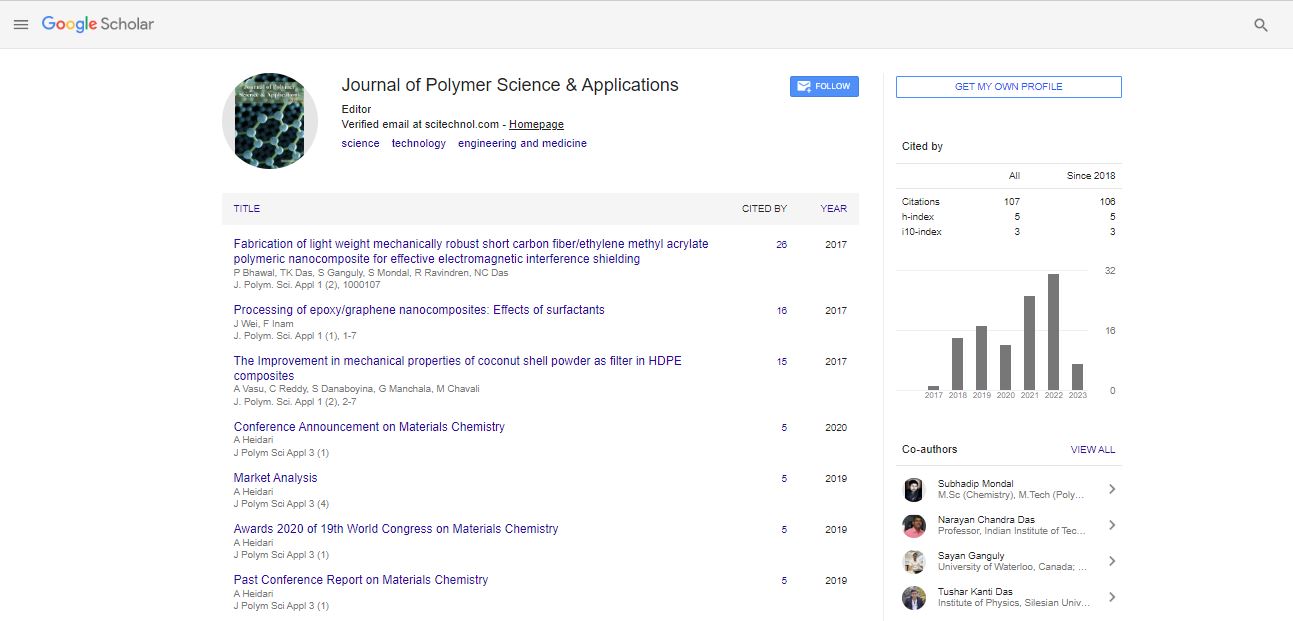Commentary, J Polym Sci Appl Vol: 7 Issue: 2
Polymer Renaissance: Navigating Comprehensive Characterization Techniques
Hui Gerg*
Department of Chemistry and Research Institute of Basic Sciences, Incheon National University, Incheon, Republic of Korea
*Corresponding Author: Hui Gerg
Department of Chemistry and Research Institute of Basic Sciences
Incheon National University Incheon, Republic of Korea
E-mail: gerghui@gmail.com
Received date: 15 May, 2023, Manuscript No. JPSA-23-106496;
Editor assigned date: 17 May, 2023, PreQC No. JPSA-23-106496(PQ);
Reviewed date: 01 June, 2023, QC No. JPSA-23-106496;
Revised date: 08 June, 2023, Manuscript No. JPSA-23-106496 (R);
Published date: 16 June, 2023, DOI: 10.4172/Jpsa.1000136
Citation: Gerg H (2023) Polymer Renaissance: Navigating Comprehensive Characterization Techniques. J Polym Sci Appl 7:2.
Description
Characterization plays a crucial role in understanding the structure, properties, and behavior of polymers. Effective characterization techniques enable researchers to gain insights into polymer composition, molecular weight, morphology, thermal properties, mechanical behavior, and more. These tools help in quality control, material selection, and the development of new materials with specific properties.
Spectroscopic techniques
Spectroscopic techniques, such as Fourier-Transform Infrared (FTIR) spectroscopy and Nuclear Magnetic Resonance (NMR) spectroscopy, provide valuable information about the chemical structure and composition of polymers.
FTIR spectroscopy analyzes the interaction of infrared radiation with the polymer sample, providing insights into functional groups, chemical bonding, and polymer conformation. It helps in identifying polymer types, detecting impurities, and monitoring chemical changes during processing or degradation. NMR spectroscopy utilizes the magnetic properties of atomic nuclei to study polymer structure and composition. It offers information about molecular connectivity, chain branching, and molecular dynamics. NMR spectroscopy is particularly useful in determining copolymer composition, tacticity, and monomer sequence distribution.
Thermal analysis techniques
Thermal analysis techniques, such as Differential Scanning Calorimetry (DSC) and Thermo Gravimetric Analysis (TGA), are essential for studying the thermal properties and behavior of polymers.
DSC measures the heat flow into or out of a polymer sample as a function of temperature. It provides information about glass transition temperature, melting temperature, crystallinity, curing behavior, and thermal stability. DSC helps in evaluating the effect of processing conditions on polymer properties and studying phase transitions.
TGA measures the weight change of a polymer sample as a function of temperature. It enables the determination of thermal stability, decomposition temperature, and the presence of fillers or additives. TGA is valuable in assessing the thermal stability of polymers in different environments and estimating their residual moisture or volatile content.
Microscopy techniques
Microscopy techniques, such as optical microscopy and Scanning Electron Microscopy (SEM), allow researchers to visualize the morphology and surface characteristics of polymers.
Optical microscopy provides information about polymer morphology, including phase separation, crystal structure, and particle dispersion. It helps in studying defects, analyzing fiber orientation, and evaluating the impact of processing parameters on the final structure.
SEM provides high-resolution images of the polymer surface, offering details about surface topography, roughness, and particle distribution. It is useful for examining fracture surfaces, analyzing polymer blends or composites, and investigating interfacial interactions.
Mechanical testing techniques
Mechanical testing techniques, such as tensile testing, impact testing, and rheology, assess the mechanical properties and performance of polymers.
Tensile testing measures the response of a polymer sample to an applied tensile load, providing information about its strength, stiffness, and elongation behavior. It helps in evaluating material properties, determining yield strength, and assessing the effect of processing conditions or additives on mechanical performance.
Impact testing measures the energy absorbed by a polymer sample during fracture, offering insights into its toughness and resistance to impact or stress. It is crucial in assessing the suitability of polymers for applications requiring high impact resistance.
Rheology studies the flow and deformation behavior of polymers under applied stress or strain. It helps in understanding polymer processing, melt behavior, viscoelastic properties, and flow characteristics. Rheological measurements aid in optimizing processing conditions and predicting the behavior of polymers during fabrication.
Conclusion
The characterization of polymers using various tools and techniques enables researchers to delve into their molecular structure, properties, and behavior. Spectroscopic techniques provide insights into chemical structure and composition, while thermal analysis techniques help in understanding thermal properties and stability. Microscopy techniques visualize the morphology and surface characteristics, while mechanical testing techniques assess mechanical properties and performance. These characterization tools play a vital role in quality control, material selection, and the development of advanced polymers for a wide range of applications. As technology continues to advance, the characterization techniques will evolve, allowing researchers to gain even deeper insights into the fascinating world of polymers.
 Spanish
Spanish  Chinese
Chinese  Russian
Russian  German
German  French
French  Japanese
Japanese  Portuguese
Portuguese  Hindi
Hindi 